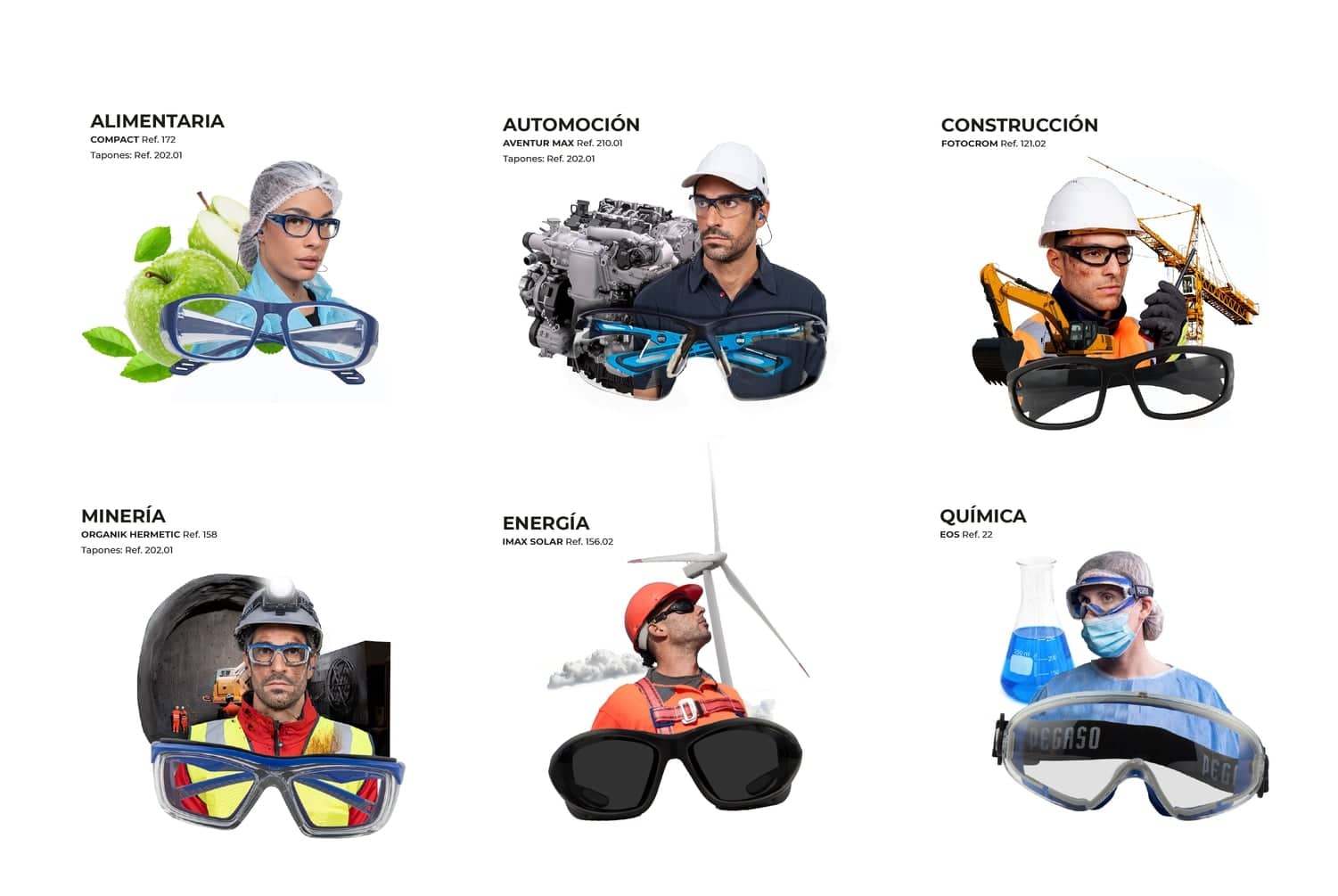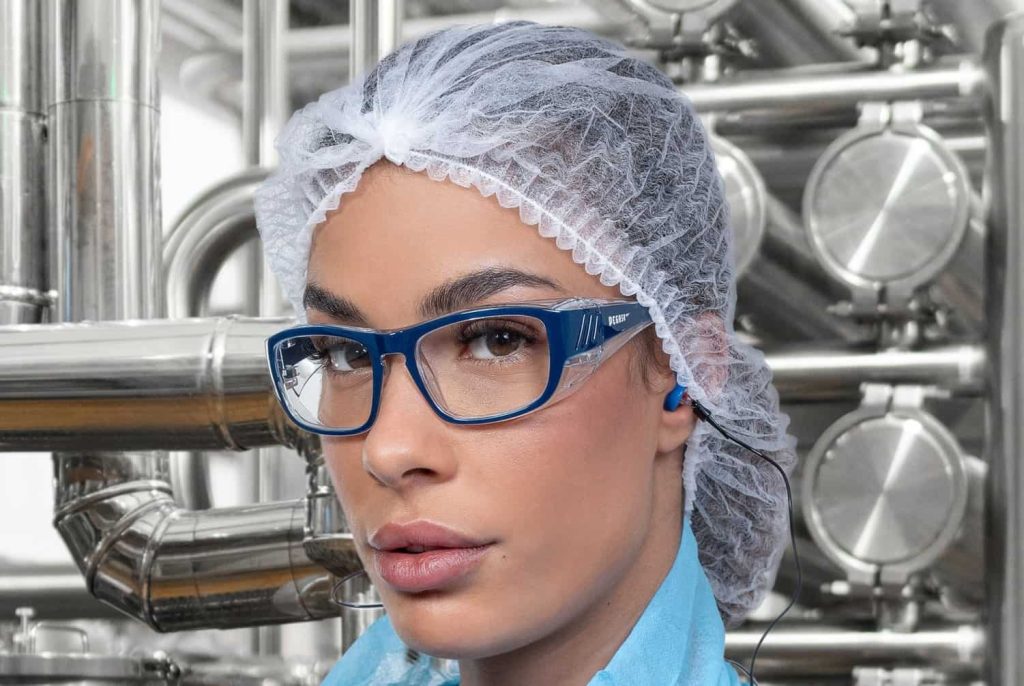Safety in the working environment is a top priority, especially in industry, where workers are exposed to various risks and hazards. One of the most important personal protective equipment (PPE) in this context is protective eyewear. These goggles are specifically designed to protect workers' eyes against injury and damage caused by flying particles, hazardous chemicals, radiation, impact and other work-related hazards.Protective eyewear is essential in a wide range of industries, including construction, manufacturing, mining, carpentry, chemical and many others. Their proper and consistent use can prevent serious eye injuries that could result in permanent vision loss or even blindness.In addition to impact and particulate protection, protective eyewear may also be necessary in environments where there is exposure to corrosive or irritating chemicals. These substances can splash or come into contact with the eyes causing serious and irreversible damage. Protective eyewear, together with other PPE such as gloves and aprons, form an effective barrier against these hazards.Another important aspect is radiation protection. In certain work environments, such as welding, the use of lasers or the handling of radioactive substances, special protective eyewear is necessary to filter radiation and protect workers' eyes.Wearing protective eyewear leads to: The following is a general description of the types of goggles and protection classes according to the risks exposed by industry.
The following is a general description of the types of goggles and protection classes according to the risks exposed by industry.
- Improving safety: proper eye protection provides adequate eye protection. This significantly decreases the risk of eye injuries caused by flying particles, chemicals, welding products and lasers.
- Promotes productivity: Wearing safety glasses allows workers to perform their tasks without being distracted by pain, eye fatigue and glare. This increases productivity and reduces the amount of time workers spend on unnecessary interruptions.
- Improves company image: The company that provides its employees with proper eye protection shows great respect for the safety of its employees. This enhances the company's image and helps strengthen the relationship between the company and its employees.
 The following is a general description of the types of goggles and protection classes according to the risks exposed by industry.
The following is a general description of the types of goggles and protection classes according to the risks exposed by industry.Automotive Industry: Safety Glasses with Side Shields and Anti-Reflective Lenses
Risks
- Exposure to Ultraviolet Light: Working in the automotive industry involves exposure to natural and artificial ultraviolet light. Ultraviolet light exposure can cause eye damage, such as cataracts and aging of ocular tissues.
- Chemical Residues: Working with chemicals in the automotive industry can lead to eye damage, including chemical burns, redness, and pain.
- Flying Particles: Workers in the automotive industry are exposed to flying particles such as dust, smoke, and liquids. These particles can cause irritation and eye damage.
Protectors
Safety glasses specifically designed to protect the eyes of automotive industry workers from damage caused by exposure to ultraviolet light, chemicals, and flying particles.Petrochemical Industry: Safety Glasses with Face Shields and Polycarbonate Lenses
Risks
- Risk of Exposure to Particles of Various Materials: Exposure to dust, particles, and vapors in the petrochemical industry can irritate the eyes and affect vision.
- Risk of Exposure to Chemicals: Chemicals used in the petrochemical industry can cause severe eye injuries if they come into contact with the eyes.
- Risk of Impact Injuries: Exposure to large objects, material fragments, and other objects in the petrochemical industry can lead to eye injuries.
Protectors
Safety glasses with ultraviolet protection filters, anti-fog treatment, and watertight seals are necessary to protect the eyes from exposure to sunlight, chemicals, particles, and other hazards.Food Industry: Safety Glasses with Frontal and Side Protectors and Mineral Safety Lenses
Risks
- Dust and Airborne Particles: Dust and airborne particles can damage the eyes upon contact with the ocular surface.
- Chemicals: Chemicals such as detergents, disinfectants, and water treatment products can be irritating to the eyes and harmful to health.
- Food Residues: Food residues and materials such as oil and grease can be irritating to the eyes and, in extreme cases, can lead to eye injuries.
- Equipment: Equipment in the food industry, such as mills, meat cutters, and food processors, can pose a risk to the eyes.
- Ultraviolet Radiation: Prolonged exposure to ultraviolet light can damage the retina and the eyes, potentially leading to blindness.
Protectors
Watertight safety glasses with protection against splashes, dust particles, food residues, and chemicals.Construction Industry: Safety Glasses with Face Shields and Polycarbonate Lenses
Risks
- Projection of Particles: The projection of particles from construction materials such as dust, cement, gravel, and gypsum can cause eye injuries.
- Lasers: Using lasers to cut metals, wood, plastic, and other materials during construction can result in severe eye damage.
- Intense Light: The use of intense work lights, such as welding equipment, can lead to eye damage if appropriate safety lenses are not used.
- Sparks: The use of power tools to cut or drill construction materials can generate sparks that may cause eye injuries.
Protectors
Safety glasses with high impact resistance, safety lenses with filters for protection against laser radiation, intense lights, sparks, and UV rays from intense lights and sparks. Welding Masks: Welding masks are used to block the intense light from welding and protect the eyes. These masks can be complemented with visors to shield the eyes from direct sunlight, particles, and lasers.Chemical Industry: Safety Glasses with Face Shields and Polycarbonate Lenses
Risks
- Chemical Burns: Exposure to irritating liquids, such as acids, chlorines, bases, and concentrated chemicals, can lead to severe eye burns.
- Dust and Gases: Many powdered chemicals and gases can cause eye irritation, inflammation, vision damage, and, in extreme cases, blindness.
- Radiation: Exposure to ultraviolet (UV) radiation or laser beams can irreparably damage the retina.
Eye Protectors
Safety glasses designed to protect the eyes from mechanical, chemical, and biological risks with lenses that offer protection against chemical and mechanical hazards, complemented by full-face shields that protect the entire facial area.Mechanical Industry: Safety Glasses for Impact Protection and Anti-Reflective Lenses
Risks
- Airborne Particles: The use of electric and mechanical tools can release small particles that may be inhaled or enter the eyes. These particles can cause eye irritation, pain, or even blindness.
- Corrosive Liquids: Chemicals and corrosive liquids can cause severe eye burns if they come into contact with the eyes.
- Ultraviolet Radiation: Prolonged exposure to ultraviolet light can damage the eyes and lead to cataracts.
- Metal Particles: Small metal particles can be propelled by power tools, compressed air, and welding equipment. These particles can cause serious eye injuries if they come into contact with the eyes.
